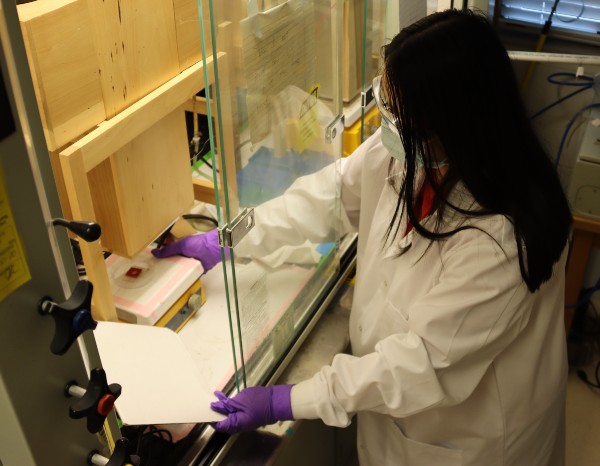A Wave of Disinfectant

PhD student Xing Li tests the effectiveness of UV radiation on a pathogen sample.
UV radiation could hold the key to combating airborne diseases
In the near future, destroying an airborne pathogen could be as easy as flipping a switch.
Ernest “Chip” Blatchley, the Lee A. Rieth Professor in Environmental Engineering, and his team are currently working on applications of UV radiation to control coronaviruses and other airborne pathogens. The structure of these pathogens makes them particularly susceptible to UV radiation.
“UV technology continues to prove to be incredibly effective in combating coronaviruses and it has been vastly underutilized,” Blatchley said. “One reason is that while UV radiation is damaging to these pathogens, it is also damaging to human skin and eyes. However, there have been recent discoveries with far-UVC radiation that may overcome this limitation.”
Blatchley said far-UVC — a narrow range of wavelengths between roughly 200-230 nm — has been shown to be effective and efficient for disinfection and decontamination of high-use spaces as well as HVAC systems and cabinet areas. It has also been shown to be far less damaging to human skin and eyes than conventional UV radiation, which could allow for people to remain in these spaces — provided the UV sources are properly used.
“The concern with UV radiation is its effect on skin and eyes, but far-UVC is absorbed by the stratum corneum and the corneal epithelium which are the exterior cells of the skin and eyes, respectively, and which are non-growing (dead) cells — so it doesn’t actually affect the skin or eye cells that are reproducing,” Blatchley said.
UV-based systems for air disinfection have been demonstrated to be effective for reducing transmission of a number of diseases that are known to be transmitted via airborne routes, including the common cold, influenza, measles and tuberculosis. The results of recent research have demonstrated that these same UV-based systems are likely to be even more effective for inactivation of coronaviruses, including SARS-CoV-2, the virus that causes COVID-19.
Civil engineering PhD student Xing Li said tests over the past 12 months have yielded very promising results. Ongoing research in this area is addressing the rates of virus inactivation by UV exposure as well as development of guidelines for testing and validation of UV-based systems for air disinfection.
“For much of what we’re researching, there isn’t a lot of existing work to follow,” she said. “While we conduct and report our efforts, we also are working to develop what should be the standard methods to disinfect these spaces.”
Blatchley’s team will continue to monitor the effectiveness of UV and far-UVC disinfection while also developing protocols for others to follow as greater international interest develops on combating current and future coronavirus outbreaks.
